Template:DRM manuscripts by collection
By Collection
Corpus Musicae Ottomanicae (CMO)
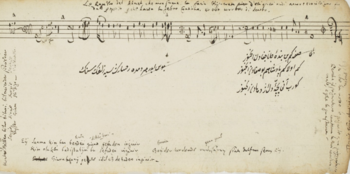
Website: Corpus Musicae Ottomanicae (CMO)
This recently announced project (2020) to digitize and transcribe manuscripts of Middle Eastern Music, named the Corpus Musicae Ottomanicae (CMO), concentrates on musical materials originating in the Middle East in the seventeenth through nineteenth centuries. A digital critical edition based on the collection is being prepared under the auspices of the Institute for Arabic and Islamic Studies at the Westphalian University in Münster, DE. Detailing of musical performance practices is an intended area of focus. ʿAlī Ufuḳī, sold to the sultan's court in Istanbul as a slave in the seventeenth century, was a rapt student of culture who gathered vast quantities of information about language and customs during his many years at court. He transliterated texts and notated melodies provide offer glimpses of style ad substance that are rare, for in general music was not notated. Custom required the music to be read from right to left.
Digital Collections in the Berlin State Library
Website: Digital Resources in the Berlin State Library
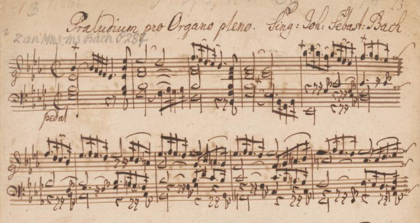
The 7,348 digitized music items at the Berlin State Library website include manuscripts, prints, libretti, poetic texts for Lieder, and much else. Of interest to Beethoven scholars are the composer's conversation books (1820, 1825, 1826). Other offerings include writings by and about Richard Wagner; music in manuscript by Franz Liszt; letters to Clara Schumann by Brahms (and many others); prints, manuscript, and letters by Mendelssohn; and copious amounts of eighteenth-century music, some of it in nineteenth-century manuscript copies.
Digitized Manuscripts in the University and Regional Library Darmstadt
Website: Digitized Manuscripts in the University and Regional Library Darmstadt
Among the 2,909 music manuscripts in the music section of this heterogeneous collection, those of Christoph Graupner play a major role. (See the Graupner entry under Thematic Catalogues.) Most of the items come from the long eighteenth century, when they sustained the life of the court and the city. Other composers of note include Attilio Ariosti, Jo. Chr. Bach, Georg Benda, Jo. Friedrich Fasch, Jo. Gottlied Graun, Jo. David Heinichen, G. Ph. Telemann, Abbé G. J. Vogler, and several nineteenth-century masters.
Rare Music Manuscripts in the British Library
Website: Rare Music Manuscripts in the British Library
See the Old Hall manuscript, Purcell's coronation anthem for James II, an excerpt from Handel's Messiah, Bach's autograph for Book Two of the Well-Tempered Clavier, Mozart's thematic catalogue of his composition, Beethoven's sketches for the Sixth Symphony ("Pastoral"), and much else. (Music manscripts make up just one part of the holdings viewable at this portal.)
E-codices: The Virtual Manuscript Library of Switzerland
Website: e-codices
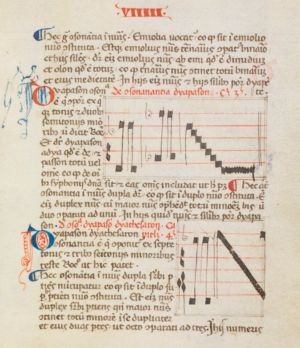
In many ways e-codices, the Virtual Manuscript Library of Switzerland, is an unsurpassed example of maximal access to fundamental but rarely seen sources. Currently serving almost 1,400 parchments and manuscripts, its online existence began in 2007. Its value to musicology owes partly to a tight coupling between early histories of music and the sources on which these accounts were often based. The digital apparatus is very clearly articulated, and it search by many rubrics is possible. Access to color images of the materials long known only from running-text summaries of them enables users to pose new questions of interpretation. Users can construct new juxtapositions and concatenations of source details in relationships that could not previously be explored. An annotation tool enables users to highlight pertinent findings. e-codices is based on like-named software, which holds the distinction of running equally well on mobile and non-mobile platforms. An author list is available here.
Among its many riches to be found are these rare items:
- Writings of Hucbaldus (840–930) from the Benedictine abbey at Einsiedeln.
- The Ars contrapunctus of Philippe de Vitry (1291–1361) from the Benedictine abbey at Einsiedeln.
- Fragment (in Latin) of a writing by Moses Maimonides (1135–1204).
Recent software enhancements and links for the e-codices newsletter are available. A tablet viewer also exists.
Early Keyboard Manuscripts at Yale University
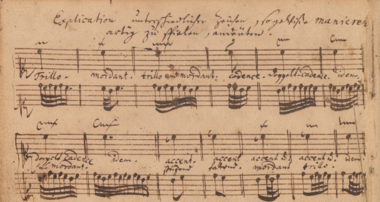
Website: Early Keyboard Manuscripts at Yale
The Beinecke Library at Yale University holds substantial collections of music manuscripts, not all of it digitized to date. Highlights include not only notebooks for members of the Bach family but also chorale settings, manuscripts by Alessandro Scarlatti, seventeenth-century English music for instrumental ensembles, and transcriptions by Ezra Pound. The Orbis catalogue linked includes a wide range of items.
Fragmentarium
Website: Fragmentarium
Fragmentarium is not so much a single project as a global effort in digital restoration to locate, identify, and, where possible enhance nominally lost fragments of medieval manuscripts. The material is not exclusively musical, but since music was an adjunct to medieval manuscripts, Fragmentarium's availability to music scholars is an important resource. Fragmentarium is based at the Universiuty of Fribourg (CH) and is directed by Christoph Früeler. As of May 2022 it included nearly 3,000 items.
Gaffurius Codices Online
Website: Gaffurius Codices Online
Franchinus Gaffurius (1451-1522) was a noted music theorist whose compositions, largely associated with his tenure as maestro di cappella at the Milan Cathedral, are little known. The Gaffurius Codices Online is devoted to inventorying the four Libroni containing the sacred vocal music he composed at this time, which coincided with the peak of Milan's Sforza rulers. (Leonardo da Vinci enjoyed a great deal of patronage from the Sforza family.) Gaffurius was a near contemporary of Josquin des Prez. The chief focus of this project is on the motets contained in the four large volumes. The contents will be captured in IIIF images suitable for sophisticated uses in a digital environment. A database containing important metadata will be developed in conjunction with the imaging. A digital critical edition is intended at a later time. the Gaffurius project is being developed by the Schola Cantorum Basiliensis in conjunction with the Swiss National Science Foundation.
Handrit: Historical (Music) Manuscripts from Iceland
Website: Historical (Music) Manuscripts from Iceland
This collection from the National and University Library, Reykjavik, contains historical manuscripts from Iceland. To find music, select Browse, Keywords, Arts, Music. Sources range from the 15th through 19th centuries.
Integrated Database for Early Music (IDEM)
Website: Integrated Database for Early Music (IDEM)
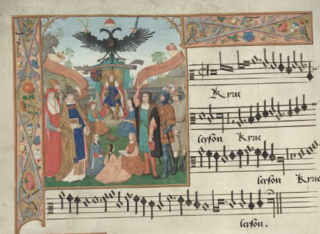
The Integrated Database for Early Music (IDEM), seated in the Musicology Research Unit (Katholieke Universiteit, Leuven), is an interdisciplinary, multifaceted database of manuscripts and printed books. Under the auspices of the Alamire Foundation, an international center for the study of music in the Low Countries, IDEM focuses on the musical heritage of these countries from the early Middle Ages until 1800.
The IDEM collection of digital images is coordinated with a central database of primary sources. Images are digitized by the Alamire Digital Lab, which provides high-technology photography at its Centre in Leuven, where state-of-the-art equipment allows musical sources to be photographed following strict quality requirements.
The Juilliard Manuscript Collection
Website: The Juilliard Manuscript Collection
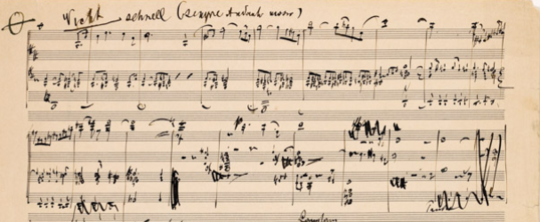
Among its 221 music manuscripts posted online, the Juilliard School possesses many unexpected items and substantial coverage of twentieth-century British and American composers (Samuel Barber, Frank Bridge) and many European composers whose music was popular in the US. Other collections represented at Juilliard include the collections of pianist Arthur Rubinstein and the popular composer of musicals Meredith Wilson (1902–1984).
Music Gifts for the Russian Emperors
Website: Music Gifts for the Russian Emperors
The National Library of Russia has made available this carefully curated collection of music given to Romanov emperors by visitors from France, Italy, Germany, and elsewhere. Many holdings come from Russia, where Western European music was introduced early in the eighteenth century. Holdings come from the 18th–20th centuries. Some of the music was brought by foreign teachers (e.g., Vincenzo Manfredini) for the royal progeny. Many works were provided with dedications to the emperors. Czech and Austrian music flowed copiously into Moscow at the end of the eighteenth century. A "Festival Song" by Felix Mendelssohn has a particularly interesting history, which is related here. The digitized pieces are linked to a database containing information about the social context and pertinent musical detail. The list of manuscripts (using Cyrillic script) can be found here, while a search engine (Roman script) is here. Drop-down lists contain listing in both Cyrillic and Roman, as appropriate, while the popup keyboard facilitates Cyrillic input. Source descriptions are in Russian.
Music Manuscripts in the Bavarian State Library
Website: Music Manuscripts in the Bavarian State Library
This rich collection of 2,697 digitized manuscripts is well endowed with music of the eighteenth and nineteenth centuries. Sample holdings include Alessandro Scarlatti's Missa Clementina, Antonio Caldara's sacred cantata "Gesu Cristo condannato", sacred vocal music by Michael Haydn, Handel's Deidamia, works by Karl Ditters von Dittersdorf, Dallapiccola, stage works by Richard Strauss, manuscripts of Carl Orff, and much other music.
The Moldenhauer Archives (Contemporary Music in Manuscript)
Website: The Moldenhauer Archives
The Moldenhauer Archives began with the focus of teaching music history through primary sources. Its founder was Hans Moldenhauer (1906-1987) made the collection a memorial after his wife, Rosaleen, and donated it to the Library of Congress and eight other libraries including the Paul Sacher Stiftung (Basel), others in Cambridge MA, Evanston IL, Munich, Vienna, Zurich, and two in the state of Washington with which the Moldenhauers had personal connections--Washington State University and Whitworth College in Spokane. Its 3,500 manuscripts and letters, while representing a history of music and musical notation from ancient to recent times, is particularly valuable for its autographs of the latter. An online guide documents its contents, in many cases with essays on individual holdings.
Music Manuscripts in the Marciana Library (Venice)
Website: Music Manuscripts in the Marciana Library
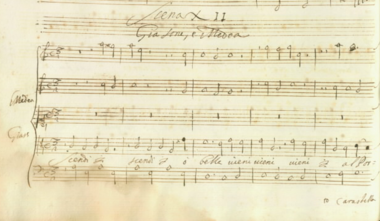
The "library of St. Mark" (i.e. the Biblioteca Nazionale "Marciana" in Venice) holds acquisitions that have been accumulating since the sixteenth century. Following guidelines widely shared across music libraries in Italy, it has digitized music manuscripts that are most closely tied to Venice's musical history. These include many important sources for seventeenth-century Venetian opera (Francesco Cavalli, Domenico Freschi, Giovanni Legrenzi, Carlo Pallavicino, P.A. and M.A. Ziani (operas can be accessed by act); 66 volumes containing cantatas of the eighteenth century by Benedetto Marcello (471 titles) and his nemesis Antonio Lotti; minuets by Baldassare Galuppi; and all the keyboard sonatas of Domenico Scarlatti (358 titles).
Music Manuscripts Online
Website: Music Manuscripts Online
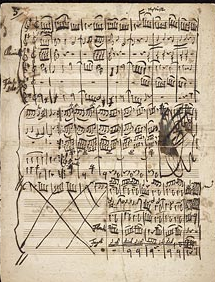
This collection of more than 700 manuscripts at the Morgan Library (New York) comes chiefly from eighteenth- to early twentieth-century composers (including but not limited to J. S. Bach, Beethoven, Brahms, Cherubini, Chopin, Debussy, Fauré, Gershwin, Glinka, Gluck, Handel, Haydn, Herbert, Liszt, Mahler, Massenet, Mendelssohn, Meyerbeer, Mozart, Mussorgsky, Paër, Pergolesi, Puccini, Saint-Saëns, Schubert, Schumann, and Wagner). An integrated browsing tool takes the viewer through music prints and manuscripts. The Library has recently made available its Goode EReader. Readers may now download images of manuscripts not currently under copyright. Searchable composer and manuscript lists facilitate individual searches.
Nuova Biblioteca Manoscritta
Website: (NBM) New Manuscript Library
The Nuova Biblioteca Manoscritta (New Manuscript Library) is a regional resource for locating (and somertimes viewing) manuscripts from the modern Venetian state. It contains almost 30,000 items, but fewer than 500 of these contain music. Many other regional resources in Italy (e.g., Florence, Lombardy) and national catalogues are listed in online catalog of the Biblioteca Scuola Superiore Normale.
ORFEUS: The Post-Tridentine Music of Silence in the Cloister of S. Bento de Castris, Evora
Website: The Post-Tridentine Music of Silence in the Cloister of S. Bento de Castris, Evora
Thirteen choirbooks from the sixteenth to the eighteenth centuries in the monastery of S. Bento de Castris, Evora (Portugal), have been digitized by CIDEHUS, the Interdisciplinary Centre for History, Culture, and Societies. Luis Hennriques directs the project. The choirbooks are described individually here.
Music Treasures Consortium
Website: Music Treasures Consortium
This aggregation includes both manuscript and out-of-copyright printed sources in more than a dozen institutions in the US, UK, and Germany. The browsing pages links users to the individual collections. The material is highly diverse but comes principally from the nineteenth century.
POLONA
Website: POLONA
Polona presents the digital collections of the National Library of Poland. Digitized manuscripts and printed music are available. Registered website users can save materials to their own collections. Printed music can be found under Biblioteka, then Nuty. Manuscripts can be found under Biblioteka, then Rękopisy; from there, go to the filters and select Gatunek, then rękopisy muzyczne. Filters are available for authors, publishers, languages, form/genres, keywords, and century.
Saxon State Library (SLUB), Dresden: Royal Private Music Collection
Website: Royal Private Music Collection, Dresden
This rich collection of the Wettin court, starting from the time of August the Strong and continuing to 1896, when it was donated to the Royal Library, is rich in holdings of sacred vocal music and Italian opera. Today it resides in the Saxon State and University Library (SLUB in the German ordering). The online holdings have been subdivided into these components:
The Opera Archive, which includes libretti, scores, and extracts, is currently being digitized. It overlaps the collaborative project Opera in Italy and Germany (1770-1830). This collection contains roughly 650 operas and opera extracts from the years 1764 to 1900. The private collections of court and church music include 750 manuscripts from the years 1697-1763.
Saxon State Library (SLUB), Dresden: Schrank II
Website: Court Music in Dresden
The current familiar name of this collection, Schrank II, is the name of the cabinet in which this important collection was long stored. It is a rich collection of instrumental music, mainly from the eighteenth century. Much of it is in the hand of Johann Georg Pisendel, an intrepid transcriber and collector of Italian (particularly Venetian) instrumental music. It contains 1,795 listings in 1750 physical manuscripts. By clicking on the highlighted text in the first sentence of the description users can download a spreadsheet with a full listing of holdings, most of which are digitized and are linked to the RISM OPAC.
Slovenian Digital Library
Website: Slovenian Digital Library
The Digital Library of Slovenia includes in its Pictures section scans of music (and articles about music) published in Slovenia. Select notno gravido from the left frame on the Pictures tab. Dates of sheet-music publication range from 1862 to 1930, with a strong concentration in the late 1920s. Songbooks, especially from the first decade of the twentieth century, are also numerous.
Spanish Digital Library (Biblioteca Nacional Hispanica)
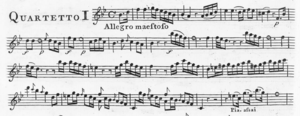
Website: Spanish Digital Library (Biblioteca Nazional Hispanica)
This heterogeneous collection of digitized materials--26,788 manuscripts and 4,347 printed sources--is impressive in its chronological and cultural range. Contains some eighteenth-century music for strings (Boccherini, Sacchini, et al.) and many sources from the late 19th and early 20th centuries.